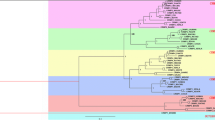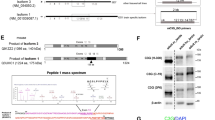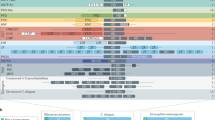Abstract
Proteins of the Caspr family are involved in cell contacts and communication in the nervous system. We identified and, by in silico reconstruction, compiled three orthologues of the human CASPR5 gene from the mouse genome, four from the rat genome, and one each from the chimpanzee, dog, opossum, and chicken genomes. Obviously, Caspr5 gene duplications have taken place during evolution of the rodent lineage. In the rat, the four paralogues are located in one chromosome arm, Chr 13p. In the mouse, however, the three Caspr5 genes are located in two chromosomes, Chr 1 and Chr 17. RT-PCR shows that all three mouse paralogues are being expressed. Common expression is found in brain tissue but different expression patterns are seen in other organs during fetal development and in the adult stage. Tissue specificity of expression has diverged during evolution of this young rodent gene family.




Similar content being viewed by others
References
Adkins R, Gelke E, Rowe D, Honeycutt R (2001) Molecular phylogeny and divergence time estimates for major rodent groups: evidence from multiple genes. Mol Biol Evol 18:777–791
Bendtsen J, Nielsen H, von Heijne G, Brunak S (2004) Improved prediction of signal peptides: Signal P 3.0. J Mol Biol 340:783–795
Hall T (1999) BioEdit: a user-friendly biological sequence alignment editor and analysis program for Windows 95/98/NT. Nuclei Acids Symp Ser 41:95–98
Jacobs L, Pilbeam D (1980) Of mice and men: fossil-based divergence dates and molecular ‘clocks.’ J Hum Evol 9:551–555
Kondrashov FA, Rogozin IB, Wolf YI, Koonin EV (2002) Selection in the evolution of gene duplications. Genome Biol 3:research 0008.1–0008.9
Kumar S, Tamura K, Jakobsen I, Nei M (2001) MEGA: Molecular evolutionary genetics analysis software. Bioinformatics 17:1244–1245
Lynch M, Conery JS (2000) The evolutionary fate and consequences of duplicate genes. Science 290:1151–1155
Massingham T, Goldman N (2005) Detecting amino acid sites under positive selection and purifying selection. Genetics 169:1753–1762
Mouse Genome Sequencing Consortium (2002) Initial sequencing and comparative analysis of the mouse genome. Nature 420:520–562
Pearson W, Lipman D (1988) Improved tools for biological sequence comparison. Proc Natl Acad Sci USA 85:2444–2448
Pearson W, Wood T, Zhang Z, Miller W (1997) Comparison of DNA sequences with protein sequences. Genomics 46:24–36
Peles E, Nativ M, Lustig M, Grumet M, Schilling J, et al. (1997) Identification of a novel contactin-associated transmembrane receptor with multiple domains implicated in protein-protein interactions. EMBO J 16:978–988
Poliak S, Peles E (2003) The local differentiation of the myelinated axons at nodes of Ranvier. Nat Rev Neurosci 4:968–980
Poliak S, Gollan L, Martinez R, Custer A, Einheber S, et al. (1999) Caspr2, a new member of the neurexin superfamily, is localized at the juxtaparanodes of myelinated axons and associates with K+ channels. Neuron 24:1037–1047
Puntervoll P, Linding R, Gemünd C, Mattingsdale M, Costantini A, et al. (2003) ELM server, a new resource for investigating short functional sites in modular eukaryotic proteins. Nucleic Acids Res 31:3625–3630
Sonnhammer E, von Heijne G, Krogh A (1998) A hidden Markov model for predicting transmembrane helices in protein sequences. In Proceedings of the Sixth International Conference on Intelligent Systems for Molecular Biology, J. Glasgow et al. eds. (Menlo Park, CA: AAAI Press), pp 175–182
Spiegel I, Salomon D, Erne B, Schaeren-Wilmers N, Peles E (2002) Caspr3 and Caspr4, two novel members of the Caspr family are expressed in the nervous system and interact with PDZ domains. Mol Cell Neurosci 20:283–297
Springer M, Murphy W, Eizirik E, O’Brien S (2003) Placental mammal diversification and the Cretaceous–Tertiary boundary. Proc Natl Acad Sci USA 100:1056–1061
Stanyon R, Yang F, Cavagna P, O’Brien P, Bagga M, et al. (1999) Reciprocal chromosome painting shows that genomic arrangements between rat and mouse proceeds ten times faster than between humans and cat. Cytogenet Cell Genet 84:150–155
Traut W, Rahn IM, Winking H, Kunze B, Weichenhan D (2001) Evolution of a 6–200 Mb long-range repeat cluster in the genus Mus. Chromosoma 110:247–252
Wang J, Li S, Zhang Y, Zheng H, Xu Z, et al. (2003) Vertebrate gene predictions and the problem of large genes. Nat Rev Genet 4:741–749
Weichenhan D (1991) Fast recovery of DNA from agarose gels by centrifugation through blotting paper. Trends Genet 7:109
Weichenhan D, Kunze B, Winking H, van Geel M, Osoegawa K, et al. (2001) Source and component genes of a 6–200 Mb gene cluster in the house mouse. Mamm Genome 12:590–594
Yang Z (1997) PAML: a program package for phylogenetic analysis by maximum likelihood. Comput Appl Biosci 13:555–556
Acknowledgments
The authors thank Enno Hartmann (Lübeck, Germany) for helpful discussions and two anonymous reviewers for useful comments. Tim Massingham (Hinxton, UK) kindly provided the SLR program. The technical assistance of Constanze Reuter, Ella Manthey, and Heidemarie Riechers (Lübeck, Germany) is highly appreciated.
Author information
Authors and Affiliations
Corresponding author
Rights and permissions
About this article
Cite this article
Traut, W., Weichenhan, D., Himmelbauer, H. et al. New members of the neurexin superfamily: multiple rodent homologues of the human CASPR5 gene. Mamm Genome 17, 723–731 (2006). https://doi.org/10.1007/s00335-005-0157-1
Received:
Accepted:
Published:
Issue Date:
DOI: https://doi.org/10.1007/s00335-005-0157-1




